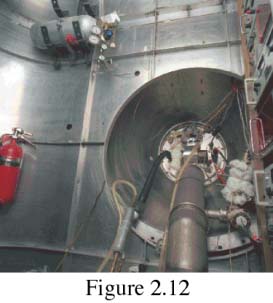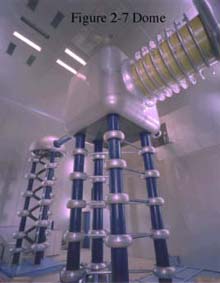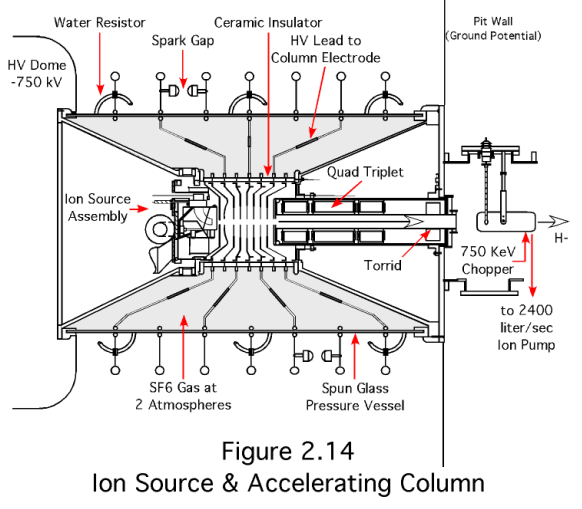|
 The Preaccelerator is the beginning of the Fermi accelerators. The H- ion created there goes through the 750 keV line, through the Linac's drift tubes and side-coupled cavities, through the 400 MeV transfer line, and on to the Booster where the H- ion gets stripped of its electrons leaving just a proton to continue the journey.
The Preaccelerator is the beginning of the Fermi accelerators. The H- ion created there goes through the 750 keV line, through the Linac's drift tubes and side-coupled cavities, through the 400 MeV transfer line, and on to the Booster where the H- ion gets stripped of its electrons leaving just a proton to continue the journey.
The Preaccelerator
The particle beam begins with a bottle of pure hydrogen (figure 2.12, upper left corner) located inside the Cockcroft-Walton dome (figure 2.7). This bottle supplies about six months worth of beam. A magnetron creates the H- ions and sends them on to their first major acceleration.
The dome is kept at a negative potential by a voltage multiplier that takes a 75 keV AC input and converts it to a -750 keV DC. The dome is insulated from its surroundings by isolators, capacitors, and Resistors.
Figure 2.7 shows the accelerating column, the dome, followed by the voltage multiplier. The dome contains everything needed to create the H- ions plus power supplies, a refrigerator system, vacuum pumps, an oscilloscope, TV camera, and a computer. All these devices require power to run, but there's no way to run an extension cord up to the dome. It would quickly and violently short out. Instead, a generator (really an alternator) located in the dome supplies all the voltage needed. An electric motor at the base of the dome rotates a fiberglass shaft in a dome leg that in turn drives the generator. A Plexiglas tube carries fiber optic communication cables and a nitrogen line to the dome.

A short distance from the ion source assembly, the beam enters the accelerating column. The column (figure 2.14) consists of seven perforated, disk-shaped titanium electrodes that guide the ion beam during its acceleration. Titanium was chosen because it requires a lot of energy to remove an electron from its surface, which reduces the chance of sparking in the column.
Ceramic rings insulate the electrodes from the outside world and from one another. Two water resistors passing from the dome through the outer edges of rings (connected to the electrode disks via rods) to the pit wall maintain equal potential differences between the disks.
The column is encased in a spun glass pressure vessel containing sulfur hexafloride gas. This gas is a good insulator and acts to reduce the possibility of the column leads arcing to each other or to ground. Spark gaps at the outer edge of the electrode rings protect the column by handling most of the current produced by a spark. Vacuum in the column is maintained by a pump located outside the pit.
Fermilab actually has two Cockcroft-Waltons named the I- Source and the H- Source. These two sources are virtually identical. They allow the lab to continually produce a particle beam without interference due to part failure, normal maintenance, or upgrades.

Accelerator Update Archive
|  The
The 
